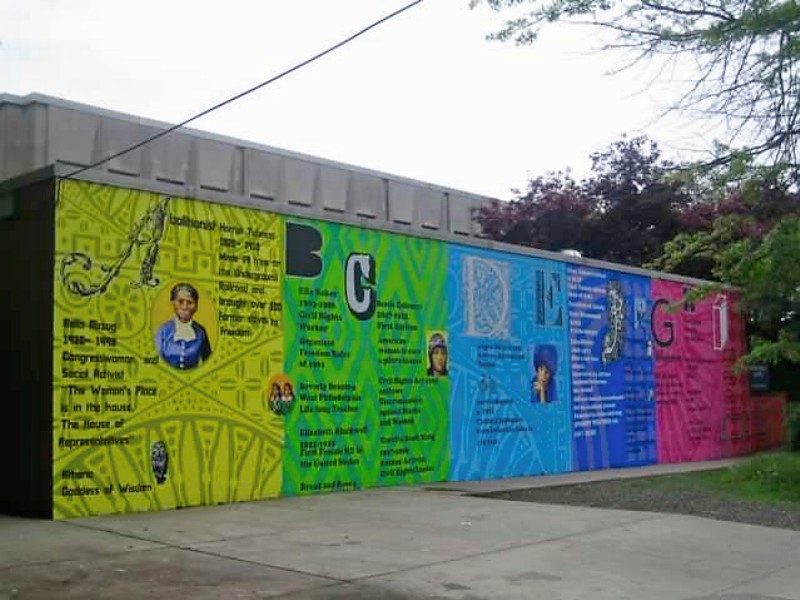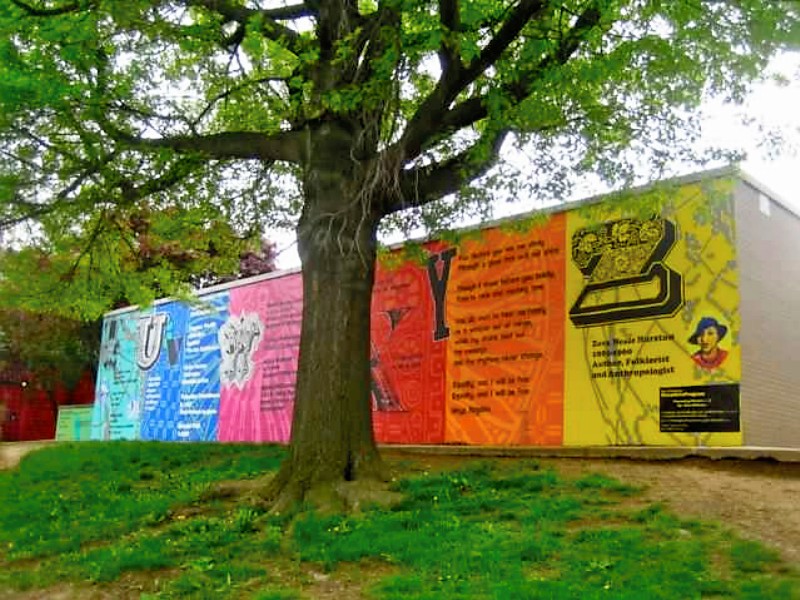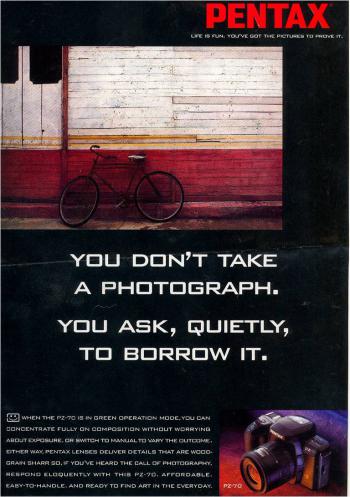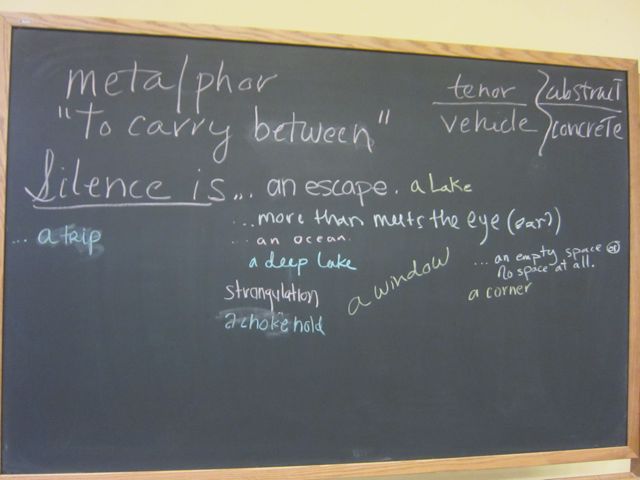Serendip is an independent site partnering with faculty at multiple colleges and universities around the world. Happy exploring!
Walled Women



POST YOUR THOUGHTS HERE
Welcome to the on-line conversation for Women in Walled Communities, a cluster of three courses in a new 360° @ Bryn Mawr College that focuses on the constraints and agency of individual actors in the institutional settings of women's colleges and prisons.
This is an interestingly different kind of place for writing, and may take some getting used to. The first thing to keep in mind is that it's not a site for "formal writing" or "finished thoughts." It's a place for thoughts-in-progress, for what you're thinking (whether you know it or not) on your way to what you think next. Imagine that you're just talking to some people you've met. This is a "conversation" place, a place to find out what you're thinking yourself, and what other people are thinking. The idea here is that your "thoughts in progress" can help others with their thinking, and theirs can help you with yours.
Who are you writing for? Primarily for yourself, and for others in our cluster. But also for the world. This is a "public" forum, so people anywhere on the web might look in. You're writing for yourself, for others in the class, AND for others you might or might not know. So, your thoughts in progress can contribute to the thoughts in progress of LOTS of people. The web is giving increasing reality to the idea that there can actually evolve a world community, and you're part of helping to bring that about. We're glad to have you along, and hope you come to both enjoy and value our shared explorations. Feel free to comment on any post below, or to POST YOUR THOUGHTS HERE.
memo 2
I emailed my paper to Barb but forgot to post.
I used this image, which Howard Zehr used in his powerpoint. My paper was about how Zehr's work relates to our experiences in the Cannery and how photographic techniques, such as zooming in and zooming, have a similar effect to reframing the words we use to describe our experience in the Cannery.
\


Can I write in such a way that every time you read it, it tells a different story?
Short but interesting podcast with Maxine Hong Kingston: http://artworks.arts.gov/?p=13152

Dinner Together in the City?
Dear 360'ers--
Barb, Jody and I would like to invite you to have dinner with us, to celebrate the conclusion of our
shared work together this semester (not to mention plotting some on-going connections and elaborations….?).
We're proposing that we do this @ 5 p.m. on Monday, Dec. 17, @ my place in center city.
We're going to order in, so please tell us what you'd like to (or cannot/will not) eat.
Getting yourself there would involve taking the R5 to Market East, then walking south
four blocks to 903 Clinton, 2R (it's just above 9th Street, between Pine and Spruce).
Let us know if you'd like to--and can!--make it?
Hopefully, and happily,
Anne (for us 3)

Inherited Silences in Eva's Man
Eva is a character whose life seems filled with silences, particularly her own. Often she will refuse to answer, refuse to explain. While I do not intend to take away her agency or voice through my interpretation of Eva’s Man, I wanted to focus particularly on what I see as inherited silences; silences that seem to have been passed down from Eva’s mother, Marie, to Eva. This mother-daughter transition represents a circle of life. This also emphasizes other circles that are present within the book and the relationships portrayed. The style of writing also works to emphasize “cycles.”
Throughout the novel Gayl Jones continually makes use of fragmented story telling, sometimes leaving little or no transition between each story. It becomes impossible to untangle each fragment and the reader is forced to see the way in which nothing is unrelated. Jones refusal to write cohesively is both inviting and uninviting. She mirrors Eva’s own contradictory emotions of desire and refusal. She gives the reader the pieces of the story but refuses to order them or explain them. Readers have to choose how to negotiate reading Eva’s Man. They either have to book at arms length or they can choose to seek clarity; choose intimacy with Eva. In a way, Eva treats the reader like she treats the men and women in her life. We are both a refused and desired audience.

How to be a women warrior under Chinese Culture?
As one unique representative of Asian cultures, Chinese culture has more traditions than many other countries. Among all these traditions, women remain in a disadvantageous for over 2000 years. The history doesn’t include the appropriate proportion of women until recent century. It’s impossible to understand Maxing Hong Kinston’s The Women Warrior without a broader background of Chinese culture as well as the environment where Chinese American live. Author made her way through to find a voice for herself under the Chinese culture castle.
Girls are told to be quite and silence is considered as a means of self-protection. The term “ghost” is used extensively throughout the article. Such a term was generally used by Chinese people to call foreigners. The phrasing ghost and ghost country clearly impose negative indications considering the unpleasant history every time when westerners showed up in the Chinese territory. The hostility and resistance towards these foreigners, whose appearance and cultures are distinctive in general, never disappeared. Such fear in addition of uncertainties in a new country made silence a default choice for a large group of Chinese Americans from the beginning.

Expectations for Final Projects
In the final projects you are co-creating for our 360 on Women in Walled Communities, we are expecting multi-pronged, cross-disciplinary endeavors that involve both collaborative and individual components, including
• a public demonstration, 1-3 pm, Mon, Dec. 17, of a tangible project that you have created together,
• which builds on the particular skills, knowledge and experience of all students in the group, and
• draws in some way on the Education, English and Criminal Justice knowledge you have acquired over the course of the semester.
In the final e-portfolio of your work, due on Serendip by 12:30, Fri, Dec. 21, we will expect critical reflection about the ways in which your final product brought together the different angles of vision (individual and disciplinary) listed above:
• how did each of the three courses/disciplines inform your final project?
• how did completing the project push your thinking in each of these disciplines?

A Rich Reading of Eva And Her Men (Web Event #4)
Reading Gayl Jones’ Eva’s Man, it was clear to me that Eva was oppressed, silenced. I saw her as a victim, and felt really bad for her and sad to think how many other women have had similar experiences. Through our class discussion, however, I began to consider that maybe it wasn’t as simple as that. It was couldntthinkofanoriginalname who first brought this to our collective attention in her post, Reflections on Eva’s Man: “all characters… are apart of a cycle of abuse…there is a larger conversation to be had about this book. One that touches upon male's oppression… and internalized sexism…” It was so easy for me at first to write off the men in Eva’s Man as oppressors, representations of the patriarchy at work. I then realized that everyone in this book, just like everyone in the world, is a victim of the patriarchy, and as such is silenced. Throughout the book, Eva chooses silence, as do some many other characters, and I began to wonder how much agency they actually had, if those silences were only chosen due to the way in which society represses and restricts. Thinking about Adrienne Rich’s analysis of silence as lying what role did Eva’s silences play in her abuse and mistreatment and is this something that she or anyone else ever has control over?

Silence in Eva's Man
During my conference with Anne we talked about me doing something "creative" for my papers in the class, rather than a typical academic essay. So, for my web event, I decided to write a haiku.
I was very drawn to the transitions throughout the book, so I decided to take the authors own words - the first set of words from the first three chapters - and put them together to form a haiku. It is both written out below and in the attached file.
The police came and1

Zine Text! Because I haven't finished the Illustrations
Gendered Silence
I started this paper with Christine Kim’s work in mind. What she displays about ownership of sound has become very visible to me; hearing people uncritically, unthoughtfully claim ownership of sound and then subject non-hearing people to the rules we establish without realizing it.

Erased Identities
Women’s sexuality is a topic often silenced by society in order to perpetuate an image of the “purity” of a woman that fits traditional gender roles. Women are expected to keep their sexualities private and, even in private, to withhold any outstanding passions or desires. When women break these gendered silences in regards to their sexuality, a tradition is ruptured and often in order to restore previous order, shame and/or violence are used as valid responses. I saw both of these instances in reading No Name Woman by Maxine Hong Kingston. This text, exemplified the complex ways in which women’s sexualities are often a source of shame in the private and public sphere. It also describes how the outcomes of rupturing these traditions can result in unsafe situations for the women who have broken the norm. Her story, can speak to the difficulty of “breaking free” within a society that does not yet accept women’s sexual freedom and that continues to perpetuate this idea by using the silencing of existence through storytelling as a warning for subsequent generations of women.

W.E. III: TO SPEAK OR NOT TO SPEAK?...THAT IS THE QUESTION! But how does one even choose when her truth is not even an option?
While reading Eva’s Man, initially, I did not find her silence troublesome. She sounded like another sexual assault victim who was too traumatized by the abuse and the act of killing to verbalize the effects of them. It was not until I read Freedom’s Silences by Wendy Brown did I begin to realize the complexities of Eva’s silence—as if the fragmented narratives in the book did not hint at them already. I now realize that Eva’s silence, in both being quiet and omitting vital information about her past and the murder, throughout the book is not as simple as her choosing to be quiet and choosing when to speak just for the hell of it. Better yet, I find that her silence, or lack thereof, speaks to the dangers, mentioned in Brown’s essay, of codifying someone’s experience when one chooses to break silence….or remain in it. Thus, I wish to explore the consequences of Eva breaking or maintaining silence, in regards to her sexuality, through the lens of Brown in hopes of relating her story to a larger, much more pressing issue in the African-American/Black community.

Does Eva have a mode of address?
Mode of address is a concept based out of film and media studies, it is a way for filmmakers to think about who their audience is going to be, a form of analysis on the power relations between the audience and the subject of the film (Ellsworth, 1997, p. 1). It allows for the filmmaker to think about ideas of class, gender sexuality, race and much more while working on their product. This process allows for them to frame their stories so that the viewer can relate or interpret it in a way that plays off of the filmmaker’s assumptions. As analytical readers, we contemplate what the author is trying to tell us and what they want us to take out of their stories. As readers, we can take this concept of mode of address and analyze why we think characters make their decisions and what the author would like us to take out of it. We can interpret their choices, the relationships they are part of or the neighborhood they live in to figure them out. Through this process we, as readers, would be exploring Gayle Jones’ mode of address in context to Eva. We would be thinking about Eva’s choices, what they mean to her and what Jones could also mean by them.

Silence as an Empty Room
As someone who has grown up in a household of artists, I’ve always had a special reverence for people’s creations. Though my mother was highly critical of her own work, there was a general sense that destroying it was in some way not acceptable. I took that to heart. My sisters’ drawings have all been kept. Old storybooks I made have just resurfaced from basement boxes. Our childhood voices are kept alive through this reverence for creation and imagination. It was for this reason that I struggled to understand an experience Maxine Hong Kingston wrote about in her memoir Woman Warrior (1975). For three years as a child, she painted over all of her artwork in black and covered up anything she wrote on the blackboard so that it couldn’t be read or seen. I struggled to understand her motives and also her complacency for what I read as a huge loss. Then I began to think of this action as a form of silence. Tillie Olsen touches on the different types of silences that exist in her essay “Silences” (1962) and these silences can be read into Hong Kingston’s blacking out.

Web Event #4: Close the Gaps
Close the Gaps
Eva’s Man by Gayl Jones chronicles the hectic, fractured life of Eva Medina Canada, whose existence has been tormented by sexual and emotional violence since girlhood. In a haunting, tangible parallel to the chaos of Eva’s experience, the novel’s narrative becomes increasingly more broken as the story progresses – eventually unraveling into a continuous narrative stream with little distinction between memory and reality. Jones’ masterful mirroring of content with form serves to draw readers in and engage them in a psychological state of chaos and confusion, not dissimilar from that of Eva’s emotional turmoil. By creating this twin experience, Jones effectively closes the social gap between readers and the story’s protagonist thus sustaining the ability for a deeper, more generative connection with the novel and its presentation of the female experience.
As a connoisseur of crime-based reality television shows like Dateline and 20/20, it was not difficult to understand what drew me to Eva’s Man. Beyond just the enticing content, however, the novel’s structure allows for readers to truly feel as though they are within the story. My loss of direction and feeling of confusion were productive in that they served to parallel the downward spiral of Eva’s emotional state as witnessed through her hectic story-telling and grim outcome of incarceration. In this way, the act of reading Eva’s Man provided an experience that allowed me to engage more deeply with the content.

Space, Comfort, and Privacy in Correctional Settings
“We also assume (mostly unconsciously) that what is good for the goose (or ourselves) must be good for the gander (“the average person”)” (Toch 5).
Picture Source: The Liberator Magazine


Privacy and Niches in Prisons and Bryn Mawr
I spent my memo thinking a lot about niches and privacy and how the two were connected. One of the things that really inspired that was considering my own niche. Here's the representation I did of it on Friday! (see also my response to Anne's question about interim spaces as niches for an explanation of this particular aspect of my niche).

Today, I feel blessed.
In my memo, I took a look at the prevalence of religious practice/belief in prison and how prisoners are able to use relgious metaphor in order to combat the negative images and perceptions of crime and criminals. 




